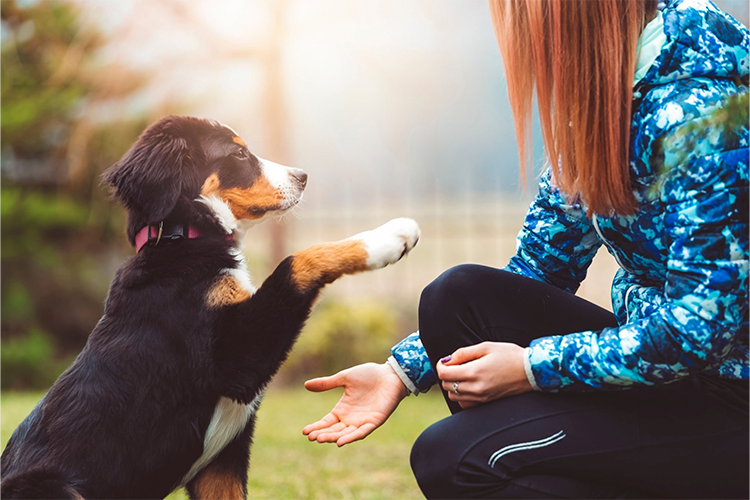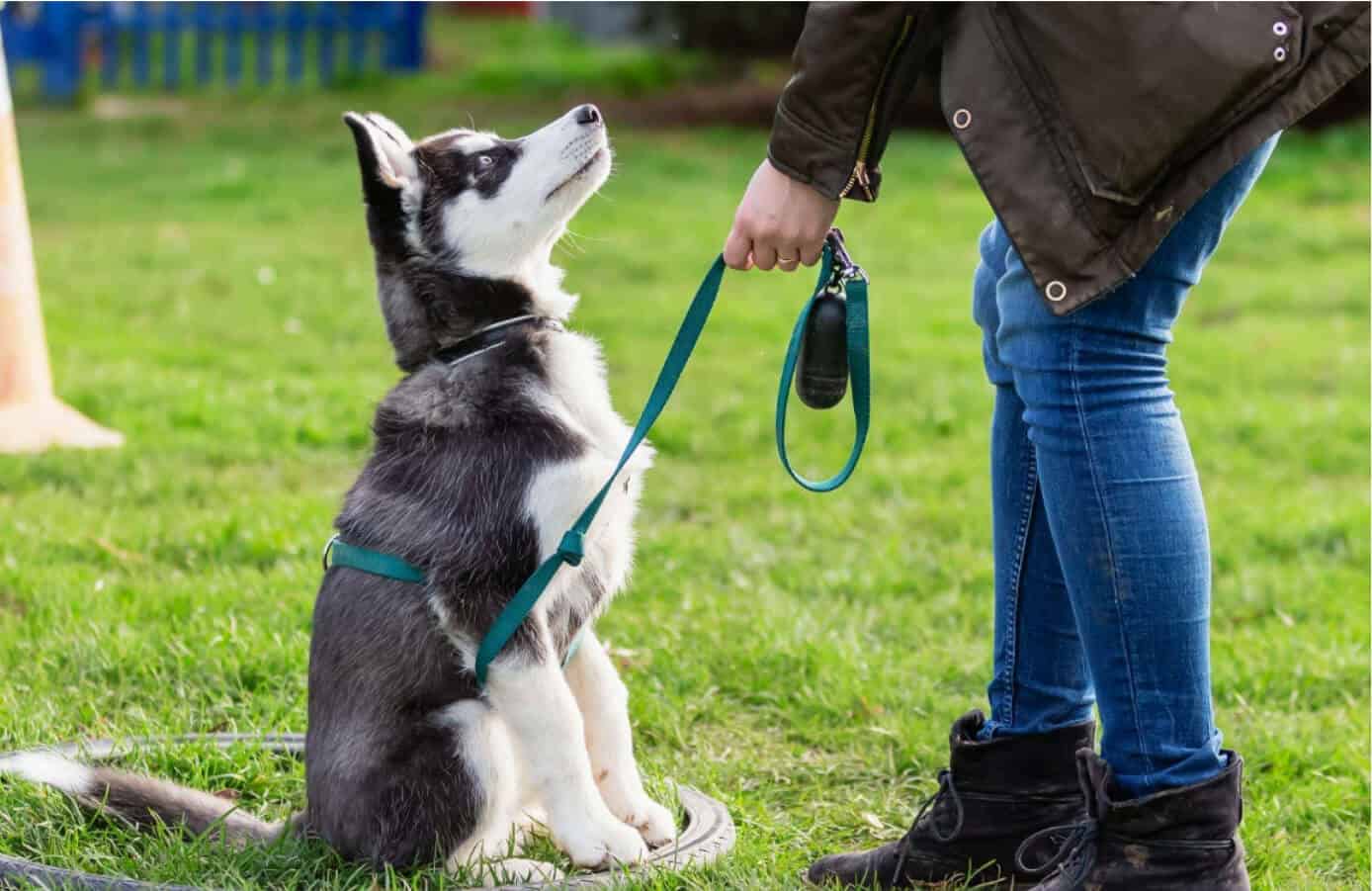Beginner's Overview to Effective Pet Training at Home
Efficiently educating a canine at home requires a nuanced understanding of canine behavior and reliable communication strategies. Developing clear training goals, making use of high-quality incentives, and preserving uniformity across family members are critical aspects. Incorporating training into day-to-day routines can boost both engagement and retention.
Understanding Pet Habits
Comprehending canine actions is necessary for efficient training and promoting a harmonious partnership in between humans and their canine companions - Puppy Training. Canines connect mainly with body language, vocalizations, and facial expressions, making it crucial for owners to translate these signals precisely. Recognizing actions such as tail wagging, roaring, or cring can provide insights into a pet's emotion and intentions
Additionally, comprehending the all-natural impulses of dogs, such as their pack way of thinking, aids proprietors develop management duties within the family. This is vital for creating a structured atmosphere where dogs feel safe and secure and are much more receptive to training. Dogs are likewise influenced by their socializing experiences; early exposure to different settings, people, and various other animals can substantially shape their behavior later in life.
Usual behavior concerns, such as aggression, stress and anxiety, or excessive barking, typically come from misunderstandings or unmet requirements. Observing and attending to these problems immediately can prevent escalation and make certain a positive training experience. By cultivating a deep understanding of pet behavior, proprietors can tailor their training methods to suit their canine friends, ultimately bring about a well-behaved and pleased family pet.

Vital Educating Tools
A well-appointed training space can considerably boost the performance of pet training at home. Vital training tools make certain that both the instructor and the dog can take part in effective sessions that foster knowing and bonding.

Purchasing a tough chain and a comfortable, well-fitting collar or harness is essential for security and control. These tools assist establish boundaries and make certain the pet dog stays protected throughout training. In addition, a designated training location, without interruptions, help concentration for both the dog and the instructor.
Training help such as training pads, cones, or agility devices can likewise enhance the experience by introducing selection and obstacles. Finally, having a note pad or electronic application for tracking progress can be important, enabling you to note successes and locations for improvement. Making use of these crucial tools will create a favorable training setting and lay the structure for reliable knowing.
Producing an Educating Regimen
Establishing a constant training routine is vital for efficient dog training in the house. A well-structured routine not just helps in strengthening wanted habits however additionally supplies your pet dog with a sense of safety and predictability. To develop a reliable training routine, start by identifying specific training goals, such as standard commands, chain strolling, or house-training.
Pick a designated time each day for training sessions, ideally when your canine is sharp and responsive. Procedure ought to be brief, about 5 to 15 minutes, to preserve emphasis and protect against exhaustion. Consistency in timing and atmosphere will certainly boost your pet dog's learning experience.
Integrate training into daily activities to enhance abilities. Technique commands throughout walks or nourishment, which incorporates finding out into all-natural regimens. Additionally, stay versatile and readjust the routine anchor as essential, suiting your canine's energy levels and mood.
Positive Reinforcement Strategies
:strip_icc()/young-woman-training-her-dog-686725227-588bab6d5f9b5874ee8bcef5.jpg)
When applying positive reinforcement, it is vital to pick rewards that are encouraging for your dog. High-value deals with, such as tiny items of poultry or cheese, can be specifically effective throughout training sessions. Furthermore, varying the rewards can maintain your dog's rate of interest and interest.
Start with easy commands, like "sit" or "remain," and progressively progress to much more intricate jobs. Consistency is vital; guarantee that all relative make use of the same commands and benefit systems to avoid confusion.
Furthermore, it is crucial to continue to be individual and stay clear of frustration. Dogs, like people, discover at their very own speed. By promoting a supportive training atmosphere with favorable support, you can enhance your pet's understanding experience while strengthening the bond in between you and your hairy friend, laying the foundation for successful training outcomes.
Typical Educating Difficulties
While training a dog at home can be a satisfying experience, it usually comes with a collection of common difficulties that can evaluate both persistence and uniformity. One widespread have a peek here problem is diversion. Dogs may become conveniently sidetracked by noises, motions, and even fragrances in their setting, making it hard to keep their focus during training sessions.
An additional obstacle is disparity in commands and reinforcement. It can puzzle the pet and hinder progress if family participants utilize various hints or benefits. Developing a unified method is crucial for reliable interaction.
In addition, canines can experience frustration or anxiety, especially if they do not comprehend what is anticipated of them. This can lead to undesirable habits, such as eating or barking.
Finally, the timing of reinforcement is vital. Delayed benefits can diminish the effectiveness of favorable support, as canines may fall short to link the actions with the incentive.
Getting over these obstacles requires dedication, clear communication, and an organized training strategy - Puppy Training. Acknowledging and addressing these typical barriers will certainly lead the means for a more successful and satisfying training experience in the house
Verdict
Finally, successful dog training at home requires a comprehensive understanding of canine actions and effective communication methods. By establishing clear training goals and utilizing top quality treats together with favorable support, the training procedure comes to be a lot more rewarding for both the pet and the instructor. Versatility, perseverance, and consistency are essential parts that facilitate learning. Inevitably, incorporating training into everyday routines enhances the bond between canine and owner, making the experience both effective and satisfying.
Developing a regular training regimen is crucial for effective canine training at home.Favorable reinforcement methods are fundamental to reliable pet training, promoting preferred behaviors via rewards instead than penalty. By fostering a supportive training environment via favorable reinforcement, you can improve your pet dog's understanding experience while strengthening the bond between you and your fuzzy buddy, laying the foundation for successful training outcomes.
In verdict, effective dog training at home requires a detailed understanding of canine behavior and efficient communication approaches. By establishing clear training goals and making use of premium deals with along with favorable support, the training procedure ends up being more fulfilling for both the pet dog and the trainer.